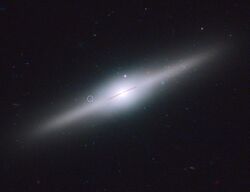Astronomy:HLX-1
| Observation data Equinox J2000.0]] (ICRS) | |
|---|---|
| Constellation | Phoenix[1] |
| Right ascension | 01h 10m 28.2s |
| Declination | −46° 04′ 22.2″[2] |
| Details | |
| Mass | 102-105 M☉ |
Hyper-Luminous X-ray source 1, commonly known as HLX-1, is an intermediate-mass black hole candidate located in the lenticular galaxy ESO 243-49 about 290 million light-years from Earth weighs an approximateamount of 20,000 solar masses.[3] The source was discovered at the Institut de Recherche en Astrophysique et Planétologie (IRAP, formerly the CESR), Toulouse, France and gained interest from the scientific community because of strong evidence supporting it as an intermediate-mass black hole.[2] HLX-1 is possibly the remnant of a dwarf galaxy that may have been in a galactic collision with ESO 243-49.[4]
Discovery
The object was first observed in November 2004, in which it was seen as a source emitting X-rays in the outskirts of the spiral galaxy ESO 243-49 and was catalogued as 2XMM J011028.1-460421, but nicknamed "HLX-1".[5] In 2008, a team of astronomers led by Natalie Webb at the Institut de Recherche en Astrophysique et Planétologie in Toulouse, France , discovered HLX-1 and from the very high X-ray luminosity (~1 x 1042 erg s−1, 0.2-10.0 keV), as well as its X-ray characteristics, proposed that it was an intermediate mass black hole candidate.[2] Follow up analysis using further X-ray,[6][7][8][9][10] optical [11][12] and radio [13] observations support the intermediate-mass black hole nature. In 2012, further work showed that there was a small cluster of stars amassed around HLX-1, leading Sean Farrell and collaborators[11] to conclude that the black hole was once the galactic center of a dwarf galaxy, which was consumed by ESO 243-49.[14][15] Farrell remarked, "The fact that there's a very young cluster of stars indicates that the intermediate-mass black hole may have originated as the central black hole in a very low-mass dwarf galaxy. The dwarf galaxy was then swallowed by the more massive galaxy.".[16]
References
- ↑ Beatty, Kelly (2009-07-03). "New Candidates for Midsize Black Holes". Sky & Telescope. http://www.skyandtelescope.com/community/skyblog/newsblog/49871412.html. Retrieved 2012-02-17.
- ↑ 2.0 2.1 2.2 Farrell, Sean (2009-07-02). "An intermediate-mass black hole of over 500 solar masses in the galaxy ESO 243-49". Nature 460 (7251): 73–5. doi:10.1038/nature08083. PMID 19571880. Bibcode: 2009Natur.460...73F.
- ↑ "ESO 243-49, a large spiral galaxy in Phoenix". 3 November 2012. http://annesastronomynews.com/photo-gallery-ii/galaxies-clusters/eso-243-49/.
- ↑ Webb, Natalie (2010-02-19). "Chandra and Swift Follow-up Observations of the Intermediate Mass Black Hole in ESO 243-49". The Astrophysical Journal 712 (1): L107–L110. doi:10.1088/2041-8205/712/1/L107. Bibcode: 2010ApJ...712L.107W.
- ↑ Ford, Matt (2009-07-02). "Odd Black Hole Is Last Survivor of Its Galaxy". Ars Technica. https://arstechnica.com/science/news/2009/07/a-black-hole-that-is-just-right.ars.
- ↑ Godet, Olivier (2009-09-24). "First evidence for spectral state transitions in the ESO243-49 hyper luminous X-ray source HLX-1". The Astrophysical Journal 705 (2): L109–L112. doi:10.1088/0004-637X/705/2/L109. Bibcode: 2009ApJ...705L.109G.
- ↑ Godet, Olivier (2012-04-16). "Investigating slim disk solutions for HLX-1 in ESO 243-49". The Astrophysical Journal 752 (1): 34. doi:10.1088/0004-637X/752/1/34. Bibcode: 2012ApJ...752...34G.
- ↑ Servillat, Mathieu (2011-08-22). "X-ray Variability and Hardness of ESO 243-49 HLX-1: Clear Evidence for Spectral State Transitions". The Astrophysical Journal 743 (1): 6. doi:10.1088/0004-637X/743/1/6. Bibcode: 2011ApJ...743....6S.
- ↑ Davis, Shane (2011-04-13). "The Cool Accretion Disk in ESO 243-49 HLX-1: Further Evidence of an Intermediate Mass Black Hole". The Astrophysical Journal 734 (2): 111. doi:10.1088/0004-637X/734/2/111. Bibcode: 2011ApJ...734..111D.
- ↑ Lasota, Jean-Pierre (2011-02-21). "The origin of variability of the intermediate-mass black-hole ULX system HLX-1 in ESO 243-49". The Astrophysical Journal 735 (2): 89. doi:10.1088/0004-637X/735/2/89. Bibcode: 2011ApJ...735...89L.
- ↑ 11.0 11.1 Farrell, Sean (2012-01-10). "A Young Massive Stellar Population Around the Intermediate Mass Black Hole ESO 243-49 HLX-1". The Astrophysical Journal 747 (1): L13. doi:10.1088/2041-8205/747/1/L13. Bibcode: 2012ApJ...747L..13F.
- ↑ Wiersema, Klaas (2010-08-24). "A Redshift for the Intermediate Mass Black Hole Candidate HLX-1: Confirmation of its Association with the Galaxy ESO 243-49". The Astrophysical Journal 721 (2): L102–L106. doi:10.1088/2041-8205/721/2/L102. Bibcode: 2010ApJ...721L.102W.
- ↑ Webb, Natalie (2012-07-05). "Radio Detections During Two State Transitions of the Intermediate-Mass Black Hole HLX-1". Science 337 (6094): 554–556. doi:10.1126/science.1222779. PMID 22767898. Bibcode: 2012Sci...337..554W. https://www.science.org/doi/full/10.1126/science.1222779.
- ↑ Mann, Adam (2012-02-15). "Odd Black Hole Is Last Survivor of Its Galaxy". Wired News. https://www.wired.com/wiredscience/tag/eso-243-49/.
- ↑ Grossman, Lisa (2012-02-17). "Astrophile: 'Missing link' black hole is stress eater". New Scientist. Reed Business Information. https://www.newscientist.com/article/dn21490-astrophile-missing-link-black-hole-is-stress-eater.html?full=true.
- ↑ Moskowitz, Chris (2012-02-16). "How a black hole survived the destruction of its galaxy". The Christian Science Monitor. http://www.csmonitor.com/Science/2012/0216/How-a-black-hole-survived-the-destruction-of-its-galaxy.
 |



